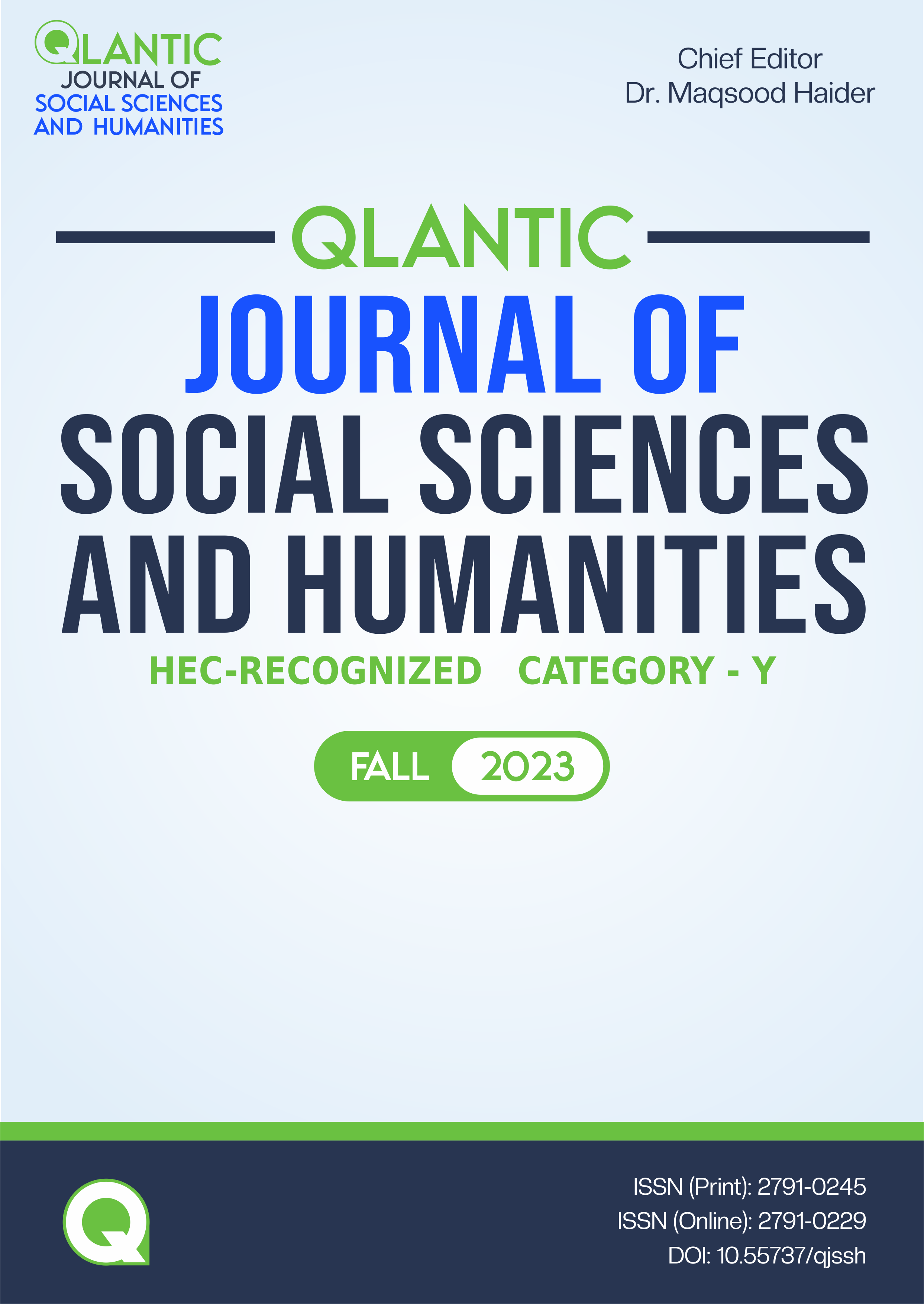Controversial Portrayal of Women in Pashto Proverbs
DOI:
https://doi.org/10.55737/qjssh.420067411Keywords:
Pashto Proverbs, Women, Role, PortrayalAbstract
This research aims to explore the controversial representation of women in Pashto proverbs. It delves into the cultural significance of these proverbs and their impact on gender roles and perceptions. Through a deep analysis of a distinct set of Pashto proverbs, this study explores the common stereotypes, biases, and gender-based discrimination fixed in these linguistic expressions. It also investigates the evolving dynamics of women's roles in Pashto society and the potential consequences of these proverbs on contemporary gender relations. The data was collected in Pashtun society, and elders were joined for this purpose. The study's findings showed that these proverbs portray women as weak and dependent, with men as their masters. The negative portrayal of women in Pashto proverbs affects their social and economic status.
References
Ahmed, A. S. (1980). Pukhtun economy and society: Traditional structure and economic development in a tribal society. London: Routledge and Kegan Paul.
Ardakani, S. N., Harehdasht, H. A., & Hajjari, L. (2015). The controversial portrayal of women in Persian proverbs. English Language and Literature Studies, 5(3), 146-155. https://doi.org/10.5539/ells.v5n3p146
Enevoldsen, J. (2004). Spogmai krang waha rakheja: Sound the bells, O Moon, arise and shine! Peshawar: Interlit Foundation.
Johnson, T. H., & Mason, M. C. (2008). No sign until the burst of fire: Understanding the Pakistan-Afghanistan frontier. International Security, 32(4), 41-77. https://doi.org/10.1162/isec.2008.32.4.41
Katozai, S. G. S. (2005). Pohana [Understanding]. Peshawar: University Publishers. https://kuscholarworks.ku.edu/dspace/bitstream/1808/5509/1/Khan_ku_0099M_10062_DATA_1.pdf
Khan, Q., & Sultana, N. (2012). Transformative education, school textbooks and gender. FWU Journal of Social Sciences, 6(2), 109-115. http://sbbwu.edu.pk/journal/WINTER-2012-vol-6-No-2/10.pdf
Khan, Q., Sultana, N., Bughio, Q., & Naz, A. (2014). Role of language in gender identity formation in Pakistani school textbooks. Indian Journal of Gender Studies, 21(1), 55-84. https://doi.org/10.1177/0971521513511200
Kiyimba, A. (2005). Gendering social destiny in the proverbs of the Baganda: Reflections on boys and girls becoming men and women. Journal of African Cultural Studies, 17(2), 253-270. https://doi.org/10.1080/13696850500448360
Kun, J. (2022). An Analysis of Sexism in Morphology and Semantics of English. International Journal of Education and Research, 10(8), 75-84. https://www.ijern.com/journal/2022/August-2022/07.pdf
Lashkari, M. A. (2005). Oulasi mataluna [Popular Proverbs]. Peshawar: Zeb Art Publishers.
Lazar, M. M. (2008). Language, communication and the public sphere: A perspective from feminist critical discourse analysis. Handbook of communication in the public sphere, 4, 89-112.
Lomotey, B. A., & Chachu, S. (2020). Gender ideologies and power relations in proverbs: A cross-cultural study. Journal of Pragmatics, 168, 69–80. https://doi.org/10.1016/j.pragma.2020.07.001
Movahhed, M. (2012). A sociological study of women in the proverbs of Lamerd in Fars Province. Woman in Culture and Art, 2, 101-120.
Rahman, R. (2017). Detecting emotion from text and emoticon. London Journal of Research in Computer Science and Technology, 17(3), 9-13. https://journalspress.com/LJRCST_Volume17/315_Detecting-Emotion-from-Text-and-Emoticon.pdf
Rahman, T. (1995). The Pashto language and identity-formation in Pakistan. Contemporary South Asia, 4(2), 151- 170. https://doi.org/10.1080/09584939508719759
Sajjadi, A. M. et al. (2008). Woman and the fall; How false beliefs about women flourished in some Persian literary texts. The Research Journal of Humanities, 57, 161-186.
Sanauddin, N. (2015). Proverbs and patriarchy: analysis of linguistic sexism and gender relations among the Pashtuns of Pakistan (Doctoral dissertation, University of Glasgow).
Sattari, J. (2009). The portrait of a woman in Iranian culture. Tehran: Markaz.
Shaheen, S. (1984). Rohi sandaray (Pakhtun songs). Peshawar: Pakhtu Academy, UOP.
Shinwari, M. M. K. (1999). Da mataluno qisay (stories of proverbs). Peshawar: Master Printers, Mohalla Jangi.
Tair, M. N. (1980). Tappa au jwand (Tappa and life). Peshawar: Pakhtu Academy, UOP.
Tair, M. N. (1982). Rohi mataluna (Pakhtu proverbs). Peshawar: Pashto Academy, UOP.
Tair, M. N. (1987). Rohi adab: Tareekh adabiat-i-Pushto (Pakhtu literature: History of Pakhtu literature). S. S. A. Shah, Trans. Peshawar: Pakhtu Academy, UOP.
Tair, M. N., & Edwards, T. C. (1982). Rohi mataluna: Pashto proverbs. Peshawar: Pashto Academy, UOP.
Tair, M. N., & Edwards, T. C. (2006). Rohi mataluna: Pashto proverbs. Peshawar: Interlit Foundation, Pashto Academy, UOP.
Talbot, M. (2003). Gender stereotypes: Reproduction and challenge. The Handbook of Language and Gender, 468-486. https://doi.org/10.1002/9780470756942.ch20
Published
Issue
Section
License
Copyright (c) 2023 Ihsan Ullah, Shakir Ullah, Noor Ur Rahim

This work is licensed under a Creative Commons Attribution-NonCommercial 4.0 International License.





